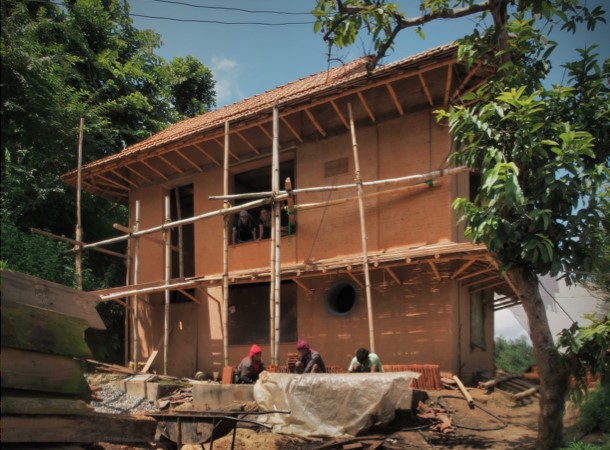Permanent Homes
Region: 8 open source manual for all of Nepal
Impact: Design submitted as recommended designs by the Government. Over 4000 downloads.
Rammed earth has taken on added significance after the earthquake since houses ABARI built with this technology withstood the shaking. - Nepali Times
Because of harsh terrain, poor economic conditions and bad infrastructure in Nepal there is no alternative to using local materials for construction. For the last eight years, we have been advocating that bamboo, earth and stone can make durable, modern and sustainable construction. The two buildings that we built in Kavre and Gorkha (right at the epicenter of the earthquake) survived unscathed. They stand as a symbol of hope for many rural people and also for people who are worried that our beautiful vernacular architecture will morph into concrete and steel or prefabricated structures brought from India and China.
In the immediate aftermath of the earthquake, we received hundreds of requests every day from people all over the world, to help in rebuilding old ancestral homes that were destroyed by the earthquake. The harsh climate of Nepal does not make temporary structures an optimal solution.
Although humbled, we were constrained. Considering the scale of the need, we decided to make an elaborate open-source design and construction manual to help people build their own homes. We shared the designs and manual through social media, websites and print media. We are also happy that government is including one of our recommended home designs in its upcoming manual for designs.
Budget Analysis
Our open source designs use only 11% foreign materials like concrete and steel and 89% of the money is spent on local labor and materials. It appropriates local materials like bamboo and earth and its earthquake resistant, promotes local craftsmanship and it is thermally comfortable.
To optimize the process, we fabricated local brick making machines (Compressed Earth Block machines) and have handed out to 3 different communities in Nuwakot, Sindhupalchok and Kavre. Using these brick presses, community members can make their own bricks and thus initiate a local enterprise. There is currently an economic blockade in Nepal imposed by India which has slowed down the fabrication process. Once it eases out, we will distribute about 50 of these machines so 300 homeowner can start making their own bricks.
Our barefoot architects have been on the ground, helping people design and their own homes. While the government is still mulling the way forward for construction, we have already built the first demonstration house for Sanu Maya Tamang in Dhulikhel, Kavre. ABARI’s first post-disaster permanent house of its kind, is a rammed earth single storey house in Bhattedanda, Kavre.
Learning from our success in making transitional shelter—that providing free information allows people to build stronger houses on their own—we designed 8 open source, modular permanent home designs for different economic, cultural and geographic brackets, with elaborate construction details. We have extensively handed out the designs to people in different villages free of cost. We have also trained more than 80 artisans and engineers just in the last 3 months. The design has been submitted to the National Reconstruction Authority, and is to be part of the recommended government designs.
Talented social entrepreneurs at Abari (the Adobe and Bamboo Research Initiative, which reuses traditional materials in contemporary construction practices) are collaborating with villagers to build earthquake resistant, light-weight houses using locally sourced materials.' - New York Times

